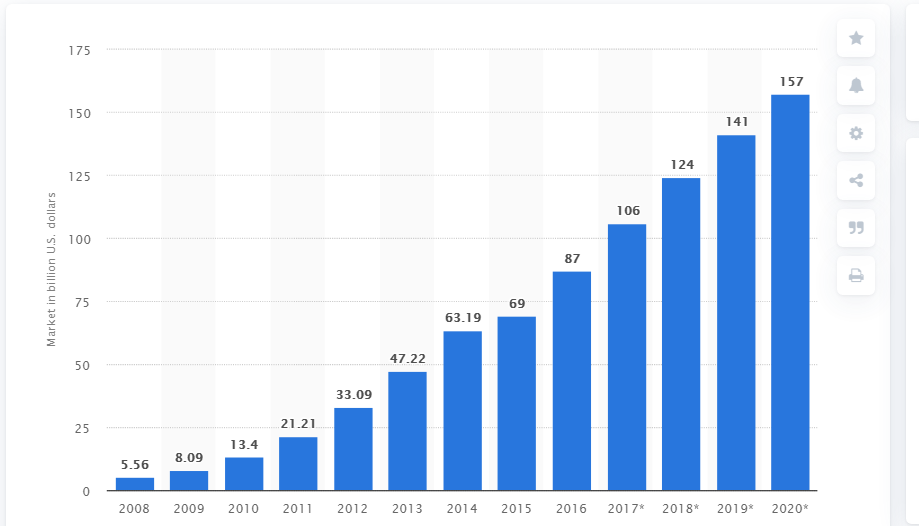The global SaaS market is over a hundred billion dollars in size and it continues to grow exponentially due to its popularity among both SaaS providers and users. SaaS is said to be the future of software product development as it has completely revolutionised the traditional models of software product licensing. As a result, the SaaS market has piqued the interest of people, especially individuals and start-ups who want to make it big in the tech world.
Naturally, ‘how to build a SaaS platform?’ is one of the many questions we get asked as a bespoke software development company. We are thrilled to pen down this how-to guide for building SaaS products for anyone who has the same question. Read on as we answer all your SaaS-related questions and break down the steps you need to take to build a successful SaaS product. But before all that, let’s rewind to the basics and understand what SaaS is.
What Is SaaS?
SaaS stands for Software-as-a-Service. It is a cloud computing model whereby a software application’s services are offered to customers over the internet for a fixed price or on a subscription basis. Unlike the traditional software licensing model, the SaaS model is an “on-demand software” business where customers can pay for the service and access the software hosted in the cloud without physically installing it on the computer device.
What Is A SaaS Product?
A SaaS product is the software application that is sold as a service to customers under this software licensing model. The fundamental difference between an on-demand SaaS product vs a non-SaaS “on-premise” application is that a SaaS application is hosted in the cloud and can be used by customers via a web browser without the need to maintain hardware and other resources.
Rising Popularity of the SaaS Model
The rapidly increasing popularity speaks for the success of the SaaS business model among the users and the service providers. According to a study, the total size of the public cloud software-as-a-service (SaaS) market was valued at $157 billion in 2020.
The total size of the public cloud software as a service (SaaS) market from 2008 to 2020 (in billion U.S. dollars)

Financial experts have forecasted the global SaaS market to grow at the same pace in the coming years due to the expected shift in all major industries towards SaaS-based structures. SaaS-based solutions offer significant advantages and, as a result, many SMEs and large organisations in the tech, financial, communication, education, retail, and healthcare industries are becoming increasingly inclined towards adopting SaaS-based solutions to replace the obsolete legacy IT structures.
Some of the main benefits of adopting a SaaS-based software solution include cost-effectiveness, ease of installation and use, flexibility, and efficient upgrades. SaaS offers the best of both worlds to the product owners as well as end-users.
Considering the many benefits of SaaS, some of the most popular software products have transitioned from a traditional model to SaaS, e.g. Adobe Photoshop. The popular graphics editing software used to be sold at a one-time price before it switched to a fully cloud-based SaaS model. This reconfiguration helped Adobe stay relevant in the changing landscape and broaden their market share.
Just like Adobe, Salesforce, Amazon, IBM, Google and Oracle are also some of the most prominent examples of SaaS providers with products that dominate today’s SaaS market. If you’re wondering how to build your own SaaS platform and be as successful as these companies, then this next section will cover everything about building SaaS products.
Steps to Build Your Own SaaS Platform
How to build your own SaaS platform – let’s get into the details of how you can turn your ideas into software products. Like any product development process, the SaaS application development process also begins with research and planning. Researching the market and planning your SaaS product according to the market landscape are the two initial steps of the process of building SaaS products.
1. Study the Market
As mentioned above, the global SaaS market is huge and it continues to expand as more and more innovative SaaS-based solutions enter the market. Therefore, it is also a highly competitive market.
Before you build your SaaS platform, you need to assess the market potential of your idea – whether your product has a market or not. A thorough market analysis lays down the foundation of product development and here are the questions you need to understand the situation of your target SaaS market.
- Who is your target customer?
- What are their main requests?
- Who are your competitors?
- What essential/unique features do they have?
- What business models do they adopt?
With the help of this questionnaire, you will better understand the market standing of your product and the competitor products that it will be up against once it is launched. This is the first step of knowing how to build a SaaS application that has market potential.
2. Plan Your Product
How to build a SaaS product efficiently – well planning is everything. After validating the market potential of your SaaS product idea, it is important to brainstorm your product idea. At this stage of the product building process, you might incorporate the insights gathered at the market research step to build upon your original idea. This is the step where you set a clear cut plan for the product you want to build.
A well-defined plan created at this stage will help you stay on track throughout the SaaS application development process. This plan will act as a blueprint for your future product and will come in handy at important stages later on. Following are a few crucial points you should mention in your plan to know exactly what you want from your SaaS product and how you want to build it.
- What does your product offer? – Having a clear idea of the features and functionalities of your SaaS platform
- Who is your target audience? – Profiling the potential customer base to understand who your customers are
- Why is there a recurring need for your product? – Understanding the motivation behind people using your SaaS product; knowing when, why, and how often they would require the services of your product
- How to communicate your product to the target audience? – Planning the marketing campaign for the product to create awareness and excitement about it
- What is the budget for product development? – Estimating the expenses of product development, creating an appropriate budget, and securing funding
- How will you monetise the SaaS product? – Deciding the pricing strategy for your product. You can choose between different pricing models such as flat-rate pricing, usage-based pricing, tiered pricing, or per feature pricing.
What you plan at this stage is not set in stone. In fact, it will probably change and evolve as you continue to build the SaaS application. But the purpose of planning is to give due consideration to important decisions that you will have to make later in the SaaS building process.
3. Define Your SaaS Requirements
With a well-defined product idea and a clear plan in mind, the next step of the SaaS product development process is to define the technical and functional requirements for the software you want to build.
Your SaaS application can have a wide-ranging set of features but there are certain features that are essential SaaS requirements for the product. You need to document all the requirements and features that you want in your SaaS application to highlight the core functionality of the product. The highest priority features will become the basis of your minimum viable product (MVP). We will discuss MVP in more detail in step 6 but for now, the following are the must-have features for every SaaS product.
- Multi-tenant architecture
- Application and data security
- Frontend UI/UX design
- Backend data management
- Third-party integrations
- User analytics and monitoring
Quality requirement documentation is important to proceed with the application development, so take your time and clearly specify the requirements and core features of your product.
4. Select a Technology Stack
Once you have a defined set of requirements for your SaaS product, next comes the step of choosing the tools and frameworks for development. This is similar to choosing the building materials for a house. Your technology stack is what is used to build and run your app.
This is a technically complicated part of the question of how to build a Saas product. Much like any other software development process, you need to select the right tools and frameworks to develop the client-facing aspects, known as the frontend, and the server-side or backend of the application.
For the front-end components of your product, you need to select tools such as HTML, CSS, and JavaScript frameworks like React, Angular, and Vue.js.
Whereas for the backend, you need frameworks that are fast, scalable, and secure. Some of the popular options to consider are Node.js, Laravel, .Net, and Ruby on Rails. SaaS products also require a database system for backend data storage and there are plenty of database options to choose from.
Lastly, the most important SaaS requirement is choosing a SaaS cloud hosting service. A reliable cloud provider completes your technology stack. For the cloud, you can choose from well-known providers such as Amazon AWS, Google Cloud, and Microsoft Azure.
Need Help Selecting a Technology Stack for your SaaS Application?
GoodCore has 15+ years of experience in the development of SaaS products and bespoke applications. Consult our team for expert advice on technology stack and MVP development of your SaaS application.
Get in Touch
5. Find a Development Team
Unless you are a software development wizard, it is unlikely that you can program a SaaS application all by yourself. For this, you need to select an expert development team that will write the software application for you. These developers will take your idea, build the SaaS application transforming it into a working piece of software ready to be launched in the market.
The success of your SaaS product depends heavily on the skills and abilities of the development team behind it. That is what makes this step crucially important. When selecting the software development team, you will be faced with multiple options such as in-house development team, outsourcing, and freelance developers.
In-house Development Team: Building your own development team by recruiting software engineers, designers, and managers to work in-house. There are various pros and cons to this approach but the most important consideration of in-house development is the amount of time and resources it takes to recruit the right people and build a capable team.
Outsourcing to a Software Development company: Outsourcing is an alternate option for an in-house development team. Instead of finding and recruiting software engineers yourself, you can outsource your product to a software development company that knows how to build SaaS products. Leveraging the experience of professional software providers will guarantee a high-quality end product that ensures a smooth user experience.
You can select a software development company that is either offshore, nearshore, or onshore, and that can work within your development budget. You can also engage with the outsourcing company in the earlier stages of the process. For instance, you can benefit from their expertise while finalising the requirements for the SaaS product or choosing the tech stack.
Hiring freelance developers: If you are wondering how to build a SaaS application at the lowest possible cost, then hiring freelance developers might be right for you. It is the cheapest option out of all but it is also the riskiest. With luck, you can find experienced developers on freelancing platforms but you will be required to micromanage their work to ensure timely completion of your project.
6. Build an MVP
A minimum viable product is a scaled-back version of your SaaS product that is built with the minimum number of features required to develop a functional and viable product. An MVP of a SaaS product is developed to be offered to the potential customers to gauge their response to the product idea before scaling up to a complete product.
MVP development is an important step in SaaS development that can help you validate your product idea, gather market feedback and test out different concepts. With the help of a successful MVP launch, you can amend and scale up your SaaS product to guarantee market success. As you build and launch the MVP into the market, you can plan the next iterations and add other features to your product to scale it up as you go.
In Search of an MVP Development Company?
GoodCore is a bespoke software development company based in the UK. We have developed MVPs for all sorts of projects, websites, and applications, for startups and mature businesses all over the globe. Reach out to us to discuss your product idea!
Contact Us
Final Thoughts on How to Build a Software as a Service Platform
SaaS is a successful model of product development and software licensing. It offers unbound potential for innovation and growth opportunities for software providers. To succeed in the SaaS market, you need to have a product that stands out in the best possible way. We hope our step-by-step guide helped you understand how to build a SaaS platform that is sure to compete in the market and win over customers.
Looking for an expert development team that knows how to build a SaaS application? GoodCore’s team will take care of SaaS development needs and help to realize your vision. Browse through our works or just reach out to us to discuss your idea.






Nice article, really informative. Thanks for sharing